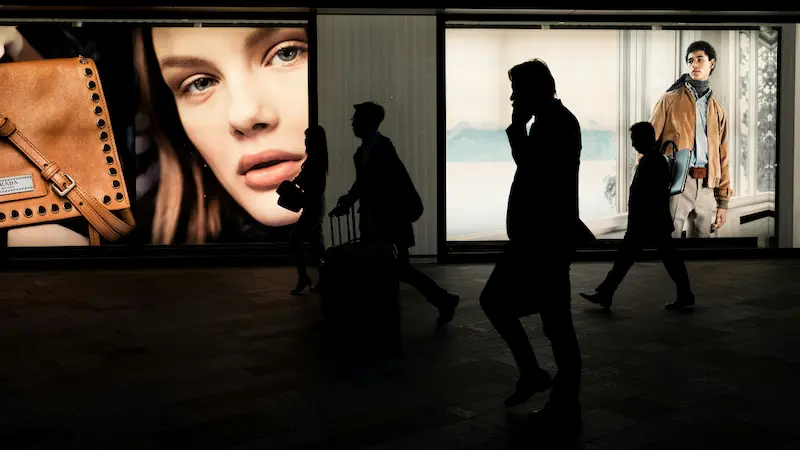
Table of Content
Businesses and organizations are always seeking innovative ways to capture attention and convey information. As a result, the gap in convenience between static and dynamic signage becomes even more pronounced. The world has seen significant transformations in display technology over the years, paving the way for dynamic signage to emerge as a game changer in visual communication. Also known as digital signage, dynamic signage is here and it's making a difference in every industry it touches.
The Evolution of Signage: Dynamic vs. Static

Signage has truly come a long way, from hand-drawn signs to photographs later replaced by printed media. Traditional static signs have been in use for the better part of history, and although reliable, they’re incapable of evolving with the pace of the constantly engaged consumer.
The full impact of the signage transformation is present in most urban centers today. With high-definition displays, interactive screens, and dynamic content management systems, dynamic signage has become ubiquitous by displaying captivating visuals that attract the modern consumer.
Understanding the Impact of Dynamic Signage
You enter your go-to-fast food joint, hungry and ready to indulge in some yummy goodness. You look around, and there’s no sign of a menu board showcasing tasty burgers and fries, no vibrant visuals with the latest deals, and certainly no digital magic bringing the meal of the day to life. Disappointing, isn’t it?
Dynamic signage captivates audiences in ways that static signs simply cannot. They provide an interactive and engaging platform for conveying information. Their absence would impact the distribution of information across various settings. For instance, directional signs, event updates, and emergency alerts when relegated to static formats would lose their impact and responsiveness.
Advantages of Dynamic Signage
Real-time Content Updates
Static signage becomes outdated the moment it’s printed or installed. Dynamic signage, on the other hand, allows for real-time content updates. This feature is precious for disseminating up-to-the-minute information, promotions, or announcements.
Enhanced Interactivity and Engagement

Consumers crave personalized experiences, and your digital signage CMS allows you to tailor your content displays to their needs and interests. They, in turn, gain interest and engage with your product/service offerings. Touchscreen capabilities allow users to engage with content by exploring product details, navigating through virtual showrooms, or participating in interactive promotions.
Flexibility in Messaging and Targeting
Dynamic signage is a highly effective tool for targeted communication. You can customize your content based on time of day, audience demographics, and even external conditions. Such adaptability ensures that the right message reaches the right audience at the right time. During a seasonal sale in retail, You can customize content to showcase product categories or discounts relevant to the demographics of the shoppers.
Case Studies: Real-world Success with Dynamic Signage
Education Sector: Case Western Reserve University in Cleveland, Ohio

Case Western Reserve University has integrated dynamic signage into its central space with a multi-story video wall at the Tinkham Veale University Center. The social wall is the center of communication and reflects the university's commitment to communication. Its position at the heart of the institution means it's the first thing people see and is therefore effective in providing information about campus activities and events. The Tinkham Veale Centre is the most visited on campus and is thus able to keep the university community well informed.
Healthcare Industry: Centene, a global healthcare provider
Centene transformed its St. Louis headquarters' lobby by using dynamic signage to tell its story. They installed a massive fine-pitch LED video wall to communicate its evolution from a modest start to the largest Medicaid managed care organization in the U.S. The creative team collaborated with Leftchannel and designed three zones on the LED screen, each representing Centene's origins, impact, and future vision. This innovative approach captivates visitors and also aligns with Centene's vision to communicate its brand values and a 30-year journey and commitment to healthcare innovation.
The Limitations of Static Signage
Stagnancy in Communication
The nature of static signs means that the message conveyed remains unchanged until manually updated. This limits its ability to address real-time events, promotions, or rapidly changing circumstances. In a world driven by constant updates, static signage becomes one-dimensional and incapable of keeping pace with business and audience needs.
Lack of Adaptability to Changing Needs
Static displays overrule the concept of real-time updates. They can’t keep up with changing trends, responding to audience preferences, or promoting time-sensitive deals. This limitation diminishes the capacity of businesses to maximize audience engagement and stay competitive.
Cost-Effectiveness of Dynamic Signage

The initial cost involved in installing a digital signage system is quite an investment, which eventually pays off in the end. Here are some of the ways it does that:
- Eliminates printing costs and saves on expenses related to design, printing, and distribution.
- Real-time content updates prevent incurring costs associated with reprinting static material.
- The use of energy-efficient LED technology results in lower long-term energy costs for businesses.
- Digital signage optimizes the impact of marketing efforts by potentially reducing wasted advertising spend.
Integration of Dynamic Signage
Retail Environments
Dynamic signage in retail entails high-definition screens positioned strategically throughout the store to capture the shopper's attention with engaging content. They display product details, promotions, and customer reviews and consequently influence purchasing decisions in real-time.
Hospitality
In the hospitality industry, signage plays the role of providing real-time updates on events and services. Digital concierge services elevate the guest experience by offering recommendations, showing interactive maps for wayfinding, and providing essential services such as dining reservations. In lobbies, interactive screens guide guests through the facility and inform them of the amenities.
Corporate Spaces
In the corporate field, dynamic signage disseminates real-time information, ranging from company announcements and updates to event schedules and milestones. In large environments, interactive screens aid in navigation for employees and visitors. Dynamic signage also contributes to sustainability by reducing paper usage and aligning with modern corporate values.
Smart Cities
Smart cities achieve their objectives through engagement and connectivity with the help of dynamic signage. IoT in smart cities facilitates real-time communication between on-street sensors, vehicles, and various devices to exchange valuable data. Dynamic signage becomes an essential interface in this interconnected ecosystem by disseminating information derived from the IoT network.
Conclusion
If you can imagine a world without dynamic signage, the full depth of its impact is now evident. Therefore, maximizing its potential is essential for businesses. This requires a tool that meets the unique needs of your business, such as Look Digital Signage. Other benefits include an advanced layout builder, offline content playback, and remote control over the content display. Book a demo, or take advantage of the free 14-day version.







